Cunard Line
![]()
This article or section needs revision. More details should be given on the discussion page. Please help improve it, and then remove this tag.
Cunard or Cunard Line is a brand of the British-American cruise company Carnival Corporation & plc for cruises in the English-speaking European market.
The brand name goes back to the former British shipping company Cunard Line, which was founded in 1839 as the British and North American Royal Mail Steam-Packet Company and initially operated a liner service from Liverpool to Boston and Halifax. As a leading competitor for the Blue Riband, it achieved a high profile and reputation with its technically advanced steamers. From 1879, under the name Cunard Steamship Company, Ltd, it grew to become one of the largest transatlantic shipping companies. At the insistence of the British government, it merged with the hitherto competing White Star Line to form Cunard-White Star, Ltd. , but reverted to its old name in 1950. With the growth of air travel, scheduled services by ship became increasingly unprofitable in the 1960s. Renamed Cunard Line Ltd. in 1962, the company was taken over by the conglomerate Trafalgar House in 1971, and after heavy losses in the 1990s, was finally bought out and broken up by Norway's Kværner in 1996. The cruise business, under the name Cunard Line, went to Carnival Corporation two years later.
Today, the British subgroup Carnival plc. operates the three ships registered in Bermuda since 2011: Queen Mary 2, Queen Elizabeth and Queen Victoria.
History
Early years (1840-1879)
In May 1839, the Canadian businessman Samuel Cunard, together with a group of well-funded shipowners and merchants such as George Burns, David McIver, Charles MacIver and James Donaldson, founded the British & North American Royal Mail Steam Packet Company, commonly known as the Cunard Line. The young company had been awarded a contract by the British Admiralty to carry mail overseas. Cunard undertook to make 14-day sailings in the summer months and 4-weekly sailings in the winter between Liverpool and Boston, Halifax and Quebec, in return for which Cunard was paid £81,000 a year. The ships of the Cunard shipping company were recognizable by a red funnel with a black cap, in 1850 two narrow black rings were added, this has not changed until today, although this pattern was partly varied in the later passenger ships.
In 1840 the first ships of the line were launched, the Britannia, Acadia, Caledonia and Columbia, all but the latter entering service in the same year. They were designed by Robert Napier, who primarily built the ship's engines and was the principal consultant on the entire project. This was the beginning of worldwide passenger and freight shipping by steamships on a large scale. Britannia and Caledonia were also the first of the line's ships to capture the Blue Ribbon for the fastest crossing of the Atlantic. In 1843, the Columbia was stranded at Cape Sable (Nova Scotia), a heavy loss for the shipping company. That same year, the newly commissioned Hibernia set another record, followed in 1845 by her sister ship Cambria. Six more newbuildings and new records followed until 1850, the Cunard Line dominated the North Atlantic.
In 1850, the Blue Riband was lost to the US shipping company Collins Line. Cunard tried to keep up, but did not succeed. The reason was that the Cunard Line still had to build wooden ships, while the competition relied on iron. It was not until 1855 that the British Admiralty, not least under the impression of the Crimean War and extremely shrunken forests on the British Isles with a resulting shortage of wood, changed its views towards the iron ship. In 1856 Cunard's first iron steamer Persia reclaimed the Blue Riband. In 1863, the new Scotia, Cunard's last paddle steamer, set another record.
In 1869, the City of Brussels of the Inman Line got the Blue Ribbon, in 1870, the first record ships of the new White Star Line followed, also the successful National Line made life difficult for the Cunard Line, one had fallen behind again. The founder Samuel Cunard, who was ennobled for his merits, was spared the decline, he died already in 1865. The British Admiralty cut the subsidies to 70,000 pounds per year and at the same time transferred the Canadian mail transport to the Inman Line, in the emigrant transport the competition was also more successful.
Cunard Steamship Company Ltd. (1879–1934)
In 1879 the financial collapse occurred and the shipping company was converted into a joint-stock company as Cunard Steamship Company Ltd. Cunard commissioned several new ships, including the Bothnia and Scythia (4557 GRT each) in 1874 and 1875, as well as the Gallia (4809 GRT), Servia (7392 GRT, the shipping company's first steel steamer) and the Aurania (7629 GRT) in 1879, 1881 and 1882. All were planned as record breakers, but none could reclaim the Blue Riband for Cunard. In 1884 Cunard then bought the Oregon from the Guion Line, which had got into financial difficulties, so Cunard had a Blue Riband racer again after 20 years, followed in 1885 by RMS Etruria and RMS Umbria (7718 GRT each), further record-breakers.
A brief interlude with Inman Line and White Star Line followed between 1888 and 1892, but in 1893 the new liners Campania and Lucania reclaimed the Blue Riband. At 12,950 GRT, both were the largest passenger ships in the world at the time and epitomized luxury and comfort. Cunard's top position seemed unchallenged, Inman, Guion and National were beaten and White Star was no match. Completely unexpectedly, new competitors appeared in the form of the German shipping companies Norddeutscher Lloyd and Hapag/HAL with record-breaking ships built at German shipyards. Much to the chagrin of the British, the Germans dominated the North Atlantic for ten years.
In 1901, the American banker John Pierpont Morgan started to buy up one shipping company after the other and, if it had been up to him, also the Cunard Line. But the British did not even think about being bought out. Cunard put pressure on Parliament and got a loan of $11.7 million approved as well as annual subsidies of $732,000 to build new ships. The culmination of this building program was the two sister ships, RMS Lusitania and RMS Mauretania, which entered service in 1907. At 31,938 GRT, these were the largest ships in the world at the time, and at more than 26 knots, they were also the fastest; the Germans were beaten. The Mauretania held the Blue Riband for the next 22 years, also a record to this day.
In 1911, Cunard Line bought up several British shipping companies, the Anchor Line, Brocklebank Line and the passenger service of the Thomson Line, followed by the Port Line in 1916. Cunard had risen to become one of the world's largest shipping groups with liner services to North America (Cunard/Anchor), India (Brocklebank/Anchor) and Australia (Port Line).
The First World War, which broke out in 1914, also claimed heavy losses of crews and ships at the Cunard Line, among which the torpedoing of the Lusitania by a German submarine was the most tragic. The Lusitania disaster claimed 1198 lives, including many Americans, which ultimately led the United States to enter the war. After the war, reconstruction began immediately and by the mid-1920s they were back in a leading position. In 1928, the Mauretania lost the Blue Riband to the liner Bremen of Norddeutscher Lloyd. Cunard countered and immediately commissioned a new record breaker, but the collapsing world economic crisis put the project in doubt. The shipping company ran out of money and construction progressed slowly. The British Treasury stepped in and supported the project with 4.5 million pounds sterling on the condition that Cunard and White Star merge.
Cunard-White Star Line (1934-1949)
→ Main article: Cunard-White Star Line
In 1934 the merger was completed and Cunard-White Star was formed. In 1936, the new liner was put into service, the Queen Mary, at 80,774 GRT the largest ship in the world at the time. The Queen Mary then also set a new record and won the Blue Riband. In 1940, the Queen Elizabeth followed, a somewhat larger ship; at 83,673 GRT, she remained the largest passenger ship in the world until 1996.
During the Second World War, the shipping company lost four passenger ships and several freighters, but with the two passenger ships Lancastria and Laconia, more than 2,000 people lost their lives each. The two 80,000-ton ships Queen Mary and Queen Elizabeth, which were used as troop carriers, survived the war unscathed, however, and from 1948 onwards the two ships were once again in weekly liner service across the Atlantic. Further newbuildings followed, and the Caronia, which entered service in 1949, was the shipping company's first ship designed primarily for cruises. In 1947, Cunard bought up the remaining White Star shares and renamed itself Cunard Steamship Company Ltd. again in 1949.
Post-war years and emerging air traffic (1949-1971)
In 1952, the Queen Mary lost the Blue Riband to the United States of the United States Lines, but Cunard no longer countered. The situation on the North Atlantic began to change fundamentally. The airplane was making itself more and more inconveniently felt. In order to participate in transatlantic air traffic, the company took over the British Eagle Airways in 1960, which was then renamed Cunard Eagle Airways. In addition, the airline BOAC-Cunard was founded two years later in cooperation with the state-owned British Overseas Airways Corporation.
In the 1960s, Cunard's transatlantic services began to decline as aircraft increasingly gained the upper hand in passenger and mail traffic across the Atlantic. The two Queens were only making losses and had to be withdrawn from service, the Queen Mary in 1967 and the Queen Elizabeth in 1968. The Queen Elizabeth 2, commissioned in 1968, the last Cunard ship from a British shipyard, already heralded new times. The QE2, as she was affectionately known, was intended not only for liner service but also for cruising, as well as being of tonnage to pass through the Panama and Suez Canals. The shipping company sought its salvation in the cruise business after liner services were discontinued in the early 1970s.
Trafalgar House Investments (1971-1998)
In 1971, Cunard Line Ltd. as the shipping company has officially been called since 1962, was bought by the British industrial group Trafalgar House Investments. In 1987, the cargo division of Cunard Line was transferred to Ellerman Lines, which also belonged to the Trafalgar House Group.
There followed purchases of various cruise lines for Cunard by Trafalgar House, such as Norske Amerikalinje AS (NAL) in 1983, Norske Cruise AS in 1986 and Royal Viking Line AS (RVL) in 1993. In the early 1990s, the Cunard fleet offered a motley impression.
Carnival Corporation (since 1998)
In 1998, Trafalgar House was bought out and broken up by the Norwegian Kværner Group. Cunard came in the same year, 97 years after the attempted takeover by J.P. Morgan, now after all under the roof of a US company. The new owner was Carnival Corporation. However, Carnival was dissatisfied with the purchase price of 425 million US dollars for the block of shares already acquired in 1998 (over 68% of Cunard) and a further 205 million US dollars in the following year for the complete takeover and brought an action against Kværner, alleging that the condition of the ships handed over was considerably worse than stated when the contract was concluded. The groups finally agreed on a 50 million US dollar repayment to Carnival.
In 2003, the American Carnival Corporation formed the world market leader Carnival Corporation & plc with P&O Princess Cruises, which had emerged from the Peninsular and Oriental Steam Navigation Company, and reorganised its subsidiaries and cruise brands. Since then, the Cunard brand has been the responsibility of the British company Carnival plc. With the Queen Mary 2, which entered service in 2004 and was the first newbuilding under the Cunard name in 28 years, Cunard took the place of a premium brand in the Carnival Group.
Since the end of 2011, the brand's three ships have no longer been registered in Southampton but in Hamilton and have accordingly been reflagged from the UK to the overseas territory of Bermuda. In autumn 2017, a further ship was ordered from Fincantieri. It is scheduled to enter service in 2022. The ship is to be measured at 113,000 GT.
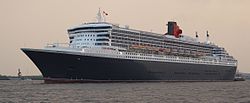
Queen Mary 2
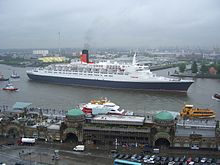
The Queen Elizabeth 2
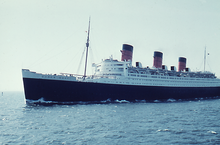
The Queen Mary
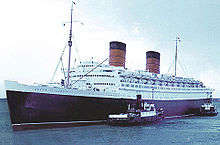
The Queen Elizabeth

The Mauretania
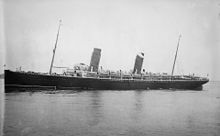
The Lucania
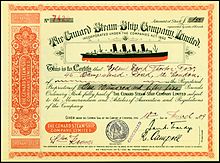
Forgery of a share of the Cunard Steamship Company Ltd from 1909
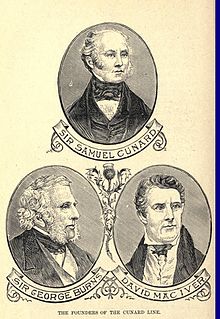
The founders of the Cunard Line: Samuel Cunard, George Burns, David MacIver
Ships
Passenger ships (transatlantic and cruise services)
| Year | Name | Tonnage | Yard | Status/Fate |
| 1840 | Britannia | 1,156 GRT | R. Duncan & Co., Glasgow | Sold to the German Imperial Fleet in 1849 |
| 1840 | Acadia | 1,156 GRT | J. Wood & Co., Glasgow | Sold to the German Imperial Fleet in 1849 |
| 1840 | Caledonia | 1,156 GRT | Smith & Rodgers, Glasgow | 1850 to span. Navy sold |
| 1840 | Columbia | 1,156 GRT | R. Steele & Co, Greenock | 1843 stranded near Seal Island (Halifax / Canada) |
| 1843 | Hibernia | 1,422 GRT | R. Steele & Co, Greenock | 1850 to span. Navy sold |
| 1845 | Cambria | 1,422 GRT | R. Steele & Co, Greenock | 1860 sold to Italy |
| 1848 | America | 1,834 GRT | R. Steele & Co, Greenock | Sold in 1866 and converted into a sailing ship |
| 1848 | Canada | 1,834 GRT | R. Steele & Co, Greenock | Sold to Portugal in 1867 and converted into a sailing ship |
| 1848 | Niagara | 1,834 GRT | R. Steele & Co, Greenock | Sold in 1866 and converted into a sailing ship |
| 1848 | Europe | 1,834 GRT | R. Steele & Co, Greenock | Sold in 1867 and converted into a sailing ship |
| 1850 | Asia (I) | 2,226 GRT | R. Napier & Sons, Glasgow | Sold in 1867 |
| 1850 | Africa | 2,226 GRT | R. Steele & Co, Greenock | Sold in 1868 |
| 1853 | Arabia (I) | 2,402 GRT | R. Steele & Co, Greenock | Sold in 1864 |
| 1856 | Persia | 3,300 GRT | R. Napier & Sons, Glasgow | Sold in 1868 and converted into a sailing ship |
| 1859 (1856) | Calabria | 2,902 GRT | J. & G. Thomson Ltd, Glasgow | 1856: Australasian for E&A / 1859 Cunard / sold in 1876 |
| 1862 | Scotia (I) | 3,871 GRT | R. Napier & Sons, Glasgow | Sold in 1878 and rebuilt into a cable ship |
| 1862 | China | 2,638 GRT | R. Napier & Sons, Glasgow | Sold to Spain in 1880 and renamed Magellanes |
| 1865 | Java | 2,696 GRT | J. & G. Thomson, Glasgow | 1878 sold to Red Star Line and renamed Zeeland |
| 1867 | Russia | 2,960 GRT | J. & G. Thomson, Glasgow | 1880 sold to Red Star Line and renamed Waesland |
| 1867 | Siberia | 2,574 GRT | J. & G. Thomson, Glasgow | Sold to Spain in 1880 and renamed Manila |
| 1868 | Samaria (I) | 2,574 GRT | J. & G. Thomson, Glasgow | Decommissioned in 1902 and sold for demolition |
| 1870 | Abyssinia | 3,376 GRT | J. & G. Thomson, Glasgow | 1880 given in payment for new building |
| 1870 | Algeria | 3,428 GRT | J. & G. Thomson, Glasgow | 1882 sold to the Red Star Line and renamed Pennland (I) |
| 1870 | Parthia | 3,167 GRT | W. Denny & Bros, Dumbarton | 1884 given in payment for new building |
| 1870 | Batavia | 2,553 GRT | W. Denny & Bros, Dumbarton | 1884 given in payment for new building |
| 1874 | Bothnia (I) | 4,557 GRT | J. & G. Thomson, Glasgow | Decommissioned in 1898 and sold for demolition |
| 1875 | Scythia (I) | 4,557 GRT | J. & G. Thomson, Glasgow | Decommissioned in 1898 and sold for demolition |
| 1879 | Gallia | 4,809 GRT | J. & G. Thomson, Glasgow | Sold to Beaver Line in 1897 |
| 1881 | Servia (I) | 7,391 GRT | J. & G. Thomson, Glasgow | 1901 out of service and sold for demolition |
| 1881 | Catalonia | 5,588 GRT | J. & G. Thomson, Glasgow | Decommissioned in 1901 and sold for demolition |
| 1882 | Cephalonia | 5,588 GRT | Laird Bros & Co, Greenock | Sold in 1900 and renamed Halior |
| 1882 | Pavonia | 5,588 GRT | J. & G. Thomson & Co., Glasgow | Decommissioned in 1900 and sold for demolition |
| 1883 | Aurania (I) | 7,269 GRT | J. & G. Thomson, Glasgow | Decommissioned in 1905 and sold for demolition |
| 1884 | Oregon | 7,324 GRT | John Elder & Co Ltd, Glasgow | 1884: for Guion Line / 1884 to Cunard / 1886 sunk |
| 1885 | Etruria | 7,718 GRT | John Elder & Co Ltd, Glasgow | Decommissioned in 1909 and sold for demolition |
| 1885 | Umbria | 7,718 GRT | John Elder & Co Ltd, Glasgow | Decommissioned in 1910 and sold for demolition |
| 1892 | Campania | 12,950 GRT | Fairfield S.B. & Eng. Co. Ltd, Glasgow | 1914 to the Royal Navy and conversion to an aircraft carrier |
| 1893 | Lucania | 12,952 GRT | Fairfield S.B. & Eng. Co. Ltd, Glasgow | Burnt out and scrapped in Liverpool in 1909 |
| 1898 | Ultonia | 10,402 GRT | C. S. Swan & Hunter Ltd, Newcastle | 1917 torpedoed and sunk in the Atlantic by U 53 |
| 1900 | Ivernia | 14,281 GRT | C. S. Swan & Hunter Ltd, Newcastle | 1917 torpedoed and sunk by UB 47 near Greece (121 dead) |
| 1900 | Saxonia | 14,281 GRT | J. Brown & Co., Clydebank | Decommissioned in 1925 and sold for demolition |
| 1902 | Carpathia | 13,603 GRT | C. S. Swan & Hunter Ltd, Newcastle | 1912 Rescue of the Titanic survivors / torpedoed and sunk in 1918 |
| 1903 | Slavonia | 10,606 GRT | John Brown & Co Ltd, Clydebank | Sunk near the Azores in 1909 |
| 1904 | Pannonia | 10,606 GRT | John Brown & Co Ltd, Clydebank | Decommissioned in 1922 and sold for demolition |
| 1905 | Carmania (I) | 19,687 GRT | John Brown & Co Ltd, Clydebank | Decommissioned in 1932 and sold for demolition |
| 1905 | Caronia | 19,687 GRT | John Brown & Co Ltd, Clydebank | Decommissioned in 1932 and sold for demolition |
| 1907 | Lusitania | 31,550 GRT | John Brown & Co Ltd, Clydebank | 1915 torpedoed and sunk by U 20 near Kinsale (Ireland) (1198 dead) |
| 1907 | Mauretania (I) | 31,938 GRT | Swan, Hunter & Wigham Rich. Ltd, Newcastle | Decommissioned in 1935 and sold for demolition |
| 1911 | Ascania (I) | 9,111 GRT | Swan, Hunter & Wigham Rich. Ltd, Newcastle | 1918 sunk near Cape Race (Canada) |
| 1911 | Franconia | 18,150 GRT | Swan, Hunter & Wigham Rich. Ltd, Newcastle | 1916 torpedoed and sunk in the Mediterranean by UB 47 |
| 1911 (1900) | Albania (I) | 7,640 GRT | Swan, Hunter & Wigham Rich. Ltd, Newcastle | 1900: Cairnrona for Cairn Line / 1911 Cunard / sold in 1912 |
| 1911 (1909) | Ausonia (I) | 7,907 GRT | Swan, Hunter & Wigham Rich. Ltd, Newcastle | 1909: Tortona for Thomson Line / 1911 Cunard / 1918 sunk |
| 1912 | Laconia | 18,150 GRT | Swan, Hunter & Wigham Rich. Ltd, Newcastle | 1917 torpedoed and sunk by U 50 at Fastnet Rock off Ireland |
| 1913 | Alaunia | 13,405 GRT | Scotts S.B. & Eng. Co. Ltd, Greenock | 1916 sunk after mine hit |
| 1913 | Andania | 13,405 GRT | Scotts S.B. & Eng. Co. Ltd, Greenock | 1918 torpedoed and sunk in the English Channel by U 46 |
| 1914 | Aquitania | 45,647 GRT | John Brown & Co Ltd, Clydebank | Decommissioned in 1950 and sold for demolition |
| 1914 (1914) | Orduna | 15,499 GRT | Harland & Wolff, Belfast | 1914 for Pacific Steam Navigation Company / 1914 chartered to Cunard / 1921 to Royal Mail Line |
| 1916 | Aurania | 13,936 GRT | Swan & Hunter, Wallsend | 1918 torpedoed and sunk off Scotland by UB 67 |
| 1916 (1891) | Feltria | 53.24 GRT | W. Denny & Bros Ltd, Dumbarton | 1891 for British India / 1916 to Cunard / 1917 torpedoed and sunk |
| 1916 (1902) | Flavia | 92.84 GRT | Palmer Bros & Co Ltd, Yarrow | 1902 for Uranium Line / 1916 to Cunard / 1918 torpedoed and sunk |
| 1916 (1907) | Folia | 65.60 GRT | Sir. J. Laing & Co. Ltd, Sunderland | 1907 for Lloyd Sabaudo / 1916 to Cunard / 1917 torpedoed and sunk |
| 1920 (1913) | Berengaria | 52,226 GRT | Blohm & Voss AG, Hamburg | 1913 Imperator for Hapag / 1920 to Cunard / 1938 scrapped after fire damage |
| 1921 | Albania (II) | 12,768 GRT | Scotts S.B. & Eng. Co. Ltd, Greenock | 1930 sold to Libera Triestina S.p.A. and renamed California |
| 1921 | Scythia | 20,277 GRT | Vickers-Armstrong Ltd, Barrows | 1958 decommissioned and sold for demolition |
| 1921 | Laconia | 19,680 GRT | Swan, Hunter & Wigham Rich. Ltd, Wallsend | 1942 torpedoed and sunk near Ascension (1658 dead) |
| 1922 | Samaria | 19,602 GRT | Cammell Laird & Co Ltd, Birkenhead | Decommissioned in 1955 and sold for demolition |
| 1922 | Andania | 14,040 GRT | Hawthorn, Leslie & Co Ltd, Newcastle | torpedoed and sunk near Reykjavík in 1940 |
| 1922 | Ausonia | 14,040 GRT | Vickers-Armstrong Ltd, Newcastle | 1942 sold to Royal Navy and converted to workshop ship |
| 1922 | Antonia | 14,040 GRT | Vickers-Armstrong Ltd, Newcastle | 1942 sold to Royal Navy and converted to workshop ship |
| 1923 | Franconia | 20,277 GRT | J. Brown & Co. Ltd, Clydebank | 1956 decommissioned and sold for demolition |
| 1924 | Carinthia | 20,277 GRT | Vickers-Armstrong Ltd, Barrows | 1924: Servia (II) / 1940 torpedoed and sunk by U 46 near Ireland |
| 1924 | Aurania | 14,040 GRT | Swan, Hunter & Wigham Rich. Ltd, Newcastle | 1942 sold to Royal Navy and converted to workshop ship |
| 1925 | Ascania | 14,040 GRT | Swan, Hunter & Wigham Rich. Ltd, Newcastle | Decommissioned in 1957 and sold for demolition |
| 1925 | Alaunia | 14,040 GRT | J. Brown & Co. Ltd, Clydebank | 1944 sold to Royal Navy and converted to a workshop ship |
| 1924 | Lancastria | 16,243 GRT | William Beardmore & Co Ltd, Glasgow | 1940 sunk near St. Nazaire by german bombers (2000 - 5000 dead ?) |
| 1936 | Queen Mary | 80,774 GRT | John Brown & Co Ltd, Clydebank | 1967 sold to the city of Long Beach in California and used as a hotel ship |
| 1939 | Mauretania | 35,738 GRT | Cammell Laird Ltd, Birkenhead | Decommissioned in 1965 and sold for demolition |
| 1940 | Queen Elizabeth | 83,673 GRT | John Brown & Co Ltd, Clydebank | 1970 sold to C.Y. Tung sold / 1972 burnt out and capsized during conversion work |
| 1948 | Parthia (II) | 13,362 GRT | Harland & Wolff Ltd, Belfast | 1961 sold to New Zealand Ship. Co. Ltd. and renamed Remuera |
| 1948 | Media (I) | 13,362 GRT | Harland & Wolff Ltd, Belfast | 1961 sold to Cogedar S.p.A. and renamed Flavia |
| 1949 | Caronia | 34,274 GRT | John Brown & Co Ltd, Clydebank | 1968 sold, 1974 scrapped |
| 1954 | Saxonia (II) | 21,989 GRT | John Brown & Co Ltd, Clydebank | 1963 Carmania (II) / sold to Soviet Union in 1973 and renamed Leonid Sobinov, scrapped in 1999 |
| 1955 | Ivernia (II) | 21,989 GRT | John Brown & Co Ltd, Clydebank | 1963 Franconia (III) / 1973 sold to Soviet Union and renamed Fedor Shalyapin, scrapped in 2004 |
| 1955 | Carinthia (III) | 21,989 GRT | John Brown & Co Ltd, Clydebank | 1968 sold to Sitmar S.p.A. and renamed Fairland, scrapped in 2005/06 |
| 1957 | Sylvania (II) | 21,989 GRT | John Brown & Co Ltd, Clydebank | 1968 sold to Sitmar S.p.A. and renamed Fairwind, scrapped in 2004 |
| 1968 | Queen Elizabeth 2 | 70,327 GT | John Brown & Co Ltd, Clydebank | Sold to Dubai in 2008, used as a hotel ship since 2018 |
| 1971 | Cunard Adventurer | 14,151 GRT | Rotterdamsche D.D. Mij. N.V.,Rotterdam | Sold to Norwegian Cruise Line A/S in 1977 and renamed Sunward II, scrapped as Cora in Alang in 2014. |
| 1972 | Cunard Ambassador | 14,151 GRT | Rotterdamsche D.D. Mij. N.V.,Rotterdam | 1974 heavily damaged by fire and sold, 1984 scrapped |
| 1975 | Cunard Countess | 17,495 GRT | Burmeister & Wain AS, Copenhagen | 2005 Lili Marleen - Holiday cruises / 2007 Ocean Countess / scrapped in Aliağa in 2014 after fire in 2013. |
| 1976 | Cunard Conquest | 17,495 GRT | Burmeister & Wain AS, Copenhagen | 1977 Cunard Princess / 1998 sold to Royal Olympic Cruise Line S.A., 1995 sold to MSC, Rhapsody, in service as Golden Iris with Mano Maritime |
| 1983 (1965) | Sagafjord | 24,002 GRT | For. et Ch. de la Mediterranée, La Seyne | 1965 for NAL / 1983 to Cunard / 1996 sold and renamed Saga Rose, 2010 scrapped |
| 1983 (1973) | Vistafjord | 24,292 GRT | Swan Hunter Shipbuilders Ltd, Newcastle | 1973 for NAL / 1983 to Cunard / 1998 Caronia (III) / 2005 sold and renamed Saga Ruby, 2017 scrapped. |
| 1986 (1984) | Sea Goddess I | 4,253 GRT | Wärtsila AB, Helsinki | 1984 for Norske Cruise AS / 1986 to Cunard / 1998 to Seabourn Cruises |
| 1986 (1984) | Sea Goddess II | 4,253 GRT | Wärtsila AB, Helsinki | 1984 for Norske Cruise AS / 1986 to Cunard / 1998 to Seabourn Cruises |
| 1993 (1988) | Royal Viking Sun | 37,845 GT | Wärtsila AB, Helsinki | 1988 for RVL / 1993 to Cunard / 1998 to Seabourn Cruises / 2002 to Holland-America Line, renamed Prinsendam / 2019 to Phoenix Reisen, renamed Amera |
| 2004 | Queen Mary 2 | 148,528 GT | Chantiers de l'Atlantique S.A., St. Nazaire | In service |
| 2007 | Queen Victoria | 90,000 GT | Fincantieri S.p.A., Marghera | In service |
| 2010 | Queen Elizabeth | 90,400 GT | Fincantieri S.p.A., Monfalcone | In service |
| 2022 (planned) | N.N. | 113,000 GT | Fincantieri S.p.A. | under construction |
Cargo ships
| Year | Name | Tonnage | Yard | Status/Fate |
| 1895 | Carinthia (I) | 5,598 GRT | London & Glasgow Eng. & I. Co. Ltd, Glasgow | Stranded near Haiti in 1900 |
| 1895 | Sylvania (I) | 5,598 GRT | London & Glasgow Eng. & I. Co. Ltd, Glasgow | Decommissioned 1910 |
| 1897 | Tyria (I) | 2,936 GRT | Workman, Clark & Co Ltd, Belfast | Decommissioned in 1928 |
| 1898 | Pavia (I) | 2,936 GRT | Workman, Clark & Co Ltd, Belfast | 1928 out of service |
| 1898 | Cypria | 2,936 GRT | Workman, Clark & Co Ltd, Belfast | 1928 out of service |
| 1899 | Veria | 3,299 GRT | A. & J. Inglis Ltd, Glasgow | 1915 sunk in the Mediterranean after bomb hit |
| 1903 | Brescia (I) | 3,255 GRT | 1929 issued / 1931 sold for demolition | |
| 1909 | Phrygia (I) | 3,352 GRT | R. Dixon & Co Ltd, Middlesbrough | Sold in 1928 |
| 1909 (1895) | Thracia | 2,891 GRT | Russell & Co Ltd, Port Glasgow | 1895: ex Orono / 1909 to Cunard / torpedoed and sunk in 1917 |
| 1909 (1896) | Lycia (I) | 2,891 GRT | Russell & Co Ltd, Port Glasgow | 1896: ex Oceano / 1909 Cunard / 1917 captured and sunk |
| 1911 (1909) | Ausonia (I) | 7,907 GRT | 1909: ex Tortona, Thomson Line / 1911 Cunard / 1918 torpedoed | |
| 1911 | Caria | 3,032 GRT | A. & J. Inglis Ltd, Glasgow | Torpedoed and sunk in 1915 |
| 1915 (1912) | Vandalia (I) | 7,333 GRT | Caird & Co Ltd, Greenock | 1912: ex Anglo-Californian / 1915 Cunard / 1918 torpedoed |
| 1915 (1912) | Vinovia | 5,503 GRT | Short Bros & Co Ltd, Sunderland | 1912: ex Anglo-Bolivian / 1915 Cunard / 1917 torpedoed |
| 1915 (1913) | Valeria | 5,865 GRT | Lithgows Ltd, Port Glasgow | 1913: ex Den of Airlie / 1915 Cunard / 1918 burnt out |
| 1915 (1913) | Volodia | 5,689 GRT | Lithgows Ltd, Port Glasgow | 1913: ex Den of Ogil / 1915 Cunard / 1917 torpedoed |
| 1916 (1910) | Valacia (I) | 6,526 GRT | Russell & Co Ltd, Port Glasgow | 1910: ex Luceric, Andrew Weir / 1916 Cunard / 1931 out of service |
| 1918 | Vasconia (I) | 5,680 GRT | Caird & Co Ltd, Greenock | 1901: ex Valverda / 1918 Cunard / sold 1927 |
| 1918 | Vardulia (I) | 5,691 GRT | Russell & Co Ltd, Port Glasgow | 1917: ex Verdun / 1918 Cunard / 1929 to Donaldson Line |
| 1919 | Virgilia | 7,889 GRT | Union Iron Works, San Francisco | 1918: ex War Rock / 1919 Cunard / sold 1937 |
| 1919 (1918) | Vultorno | 5,764 GRT | Northwest Steel Co., Portland | 1918: ex War Viceroy / 1919 Cunard / sold 1923 |
| 1919 (1918) | Vellavia | 5,272 GRT | Armstrong, Whitworth & Co Ltd, Newcastle | 1918: ex War Setter / 1919 Cunard / sold 1925 |
| 1919 (1918) | Vennonia | 5,225 GRT | Caledon SB & Eng. Co. Ltd, Dundee | 1918: ex War Carp / 1919 Cunard / sold 1923 |
| 1919 (1918) | Venusia | 5,222 GRT | Harland & Wolff Ltd, Belfast | 1918: ex War Snake / 1919 Cunard / 1923 sold |
| 1919 (1918) | Verentia | 5,185 GRT | Harland & Wolff Ltd, Belfast | 1918: ex War Lemur / 1919 Cunard / 1926 sold to Andrew Weir, Foreric |
| 1919 (1918) | Verbania | 5,021 GRT | Harland & Wolff Ltd, Belfast | 1918: ex Trafalgar / 1919 Cunard / sold 1926 |
| 1919 (1918) | Vitellia | 4,449 GRT | Earles SB Co Ltd, Hull | 1918: ex War Pintail / 1919 Cunard / 1919 sold to Anchor Line |
| 1919 (1918) | Vindelia | 4,340 GRT | W. Gray & Co Ltd, West Hartlepool | 1918: ex War Wagtail / 1919 Cunard / sold 1924 |
| 1928 | Bothnia (II) | 2,407 GRT | J. L. Thompson & Sons Ltd, Sunderland | 1956 sold |
| 1928 | Bactria | 2,407 GRT | J. L. Thompson & Sons Ltd, Sunderland | 1954 sold |
| 1928 | Bantria | 2,407 GRT | J. L. Thompson & Sons Ltd, Sunderland | 1954 sold to Costa Armatori, Giorgina Costa |
| 1928 | Bosnia | 2,407 GRT | J. L. Thompson & Sons Ltd, Sunderland | Torpedoed and sunk in 1939 |
| 1945 | Brescia (II) | 3,834 GRT | Consolidated Steel Corp., Wilmington | Sold in 1966 |
| 1946 (1943) | Vasconia (II) | 7,058 GRT | Short Bros & Co Ltd, Sunderland | 1943: ex Empire Pendennis, MOWT / 1946 Cunard / 1950 to BSL, Fresno Star |
| 1946 (1943) | Valacia (II) | 7,058 GRT | Harland & Wolff Ltd, Belfast | 1943: ex Empire Camp, MOWT / 1946 Cunard / 1950 to BCL, New York City |
| 1947 (1944) | Vandalia(II) | 6,921 GRT | Barclay, Curle & Co Ltd, Glasgow | 1944: ex Samfoyle, MOWT / 1947 Cunard / 1954 sold |
| 1947 (1941) | Vardulia (II) | 6,237 GRT | C. Connell & Co. Ltd, Glasgow | 1941: ex Granville Stuart, MOWT / 1947 Cunard / 1954 sold |
| 1947 | Asia (II) | 8,723 GRT | J. Laing & Sons Ltd, Sunderland | Sold in 1963 |
| 1950 | Assyria | 8,530 GRT | Swan, Hunter Shipbuilders Ltd, Newcastle | Sold in 1963 |
| 1951 (1948) | Alsatia (II) | 7,228 GRT | J. L. Thompson & Sons Ltd, Sunderland | 1948: ex Silverplane, Silver Line / 1951 Cunard / 1963 sold |
| 1951 (1949) | Andria (I) | 7,228 GRT | J. L. Thompson & Sons Ltd, Sunderland | 1949: ex Silverbriar, Silver Line / 1951 Cunard / 1963 sold |
| 1953 | Pavia (II) | 3,534 GRT | W. Hamilton & Co. Ltd, Glasgow | Sold in 1965 |
| 1954 | Lycia (II) | 3,534 GRT | W. Hamilton & Co. Ltd, Glasgow | Sold in 1965 |
| 1955 | Phrygia (II) | 3,534 GRT | W. Hamilton & Co. Ltd, Glasgow | Sold in 1965 |
| 1955 (1948) | Arabia (II) | 8,720 GRT | J. Laing & Sons Ltd, Sunderland | 1948: ex Castillian, Ellerman Lines / 1955 Cunard / 1963 sold |
| 1955 | Tyria (II) | 5,869 GRT | W. Doxford & Co Ltd, Sunderland | 1959 sold |
| 1959 | Andania (III) | 7,004 GRT | W. Hamilton & Co. Ltd, Glasgow | Sold to Brocklebank Line in 1969, Macharda |
| 1960 | Alaunia (III) | 7,004 GRT | W. Hamilton & Co. Ltd, Glasgow | Sold to Brocklebank Line in 1969, Malancha |
| 1961 | Maronia | 20,259 GRT | Vickers-Armstrong Ltd, Newcastle | Sold in 1966 |
| 1963 | Media (II) | 7,004 GRT | W. Hamilton & Co. Ltd, Glasgow | 1971 sold |
| 1963 | Parthia (III) | 5,149 GRT | Caledon SB & Eng. Co. Ltd, Dundee | 1971 sold |
| 1963 | Saxonia (III) | 5,586 GRT | W. Hamilton & Co. Ltd, Glasgow | 1968 sold to Brocklebank Line, Mahronda |
| 1964 | Ivernia (III) | 5,589 GRT | Swan, Hunter & W. Rich. Ltd, Newcastle | 1968 sold to Brocklebank Line, Manipur |
| 1964 | Samaria (III) | 16,682 GRT | Govan Shipbuilders Ltd, Govan | Sold to Harrison Line in 1969, Scholar |
| 1964 | Scythia (III) | 5,349 GRT | W. Hamilton & Co. Ltd, Glasgow | Sold to Harrison Line in 1969, Merchant |
| 1966 (1956) | Assyria (II) | 7,739 GRT | Barclay, Curle & Co Ltd, Glasgow | 1956: ex Almerian, Ellerman Lines / 1966 Cunard / 1967: Asia (III) / 1969 sold |
| 1966 (1963) | Scotia (II) | 8,063 GRT | C. Connell & Co. Ltd, Glasgow | 1963: ex Benarmin, Ben Line / 1966 Cunard / sold 1970 |
Reefers
| Year | Name | Tonnage | Yard | Status/Fate |
| 1961 (1954) | Nordia | 3,534 GRT | W. Hamilton & Co. Ltd, Glasgow | 1954: Maritime Cargo & Fruit Co. / 1961 Cunard / 1963 sold |
| 1974 (1973) | Andria (III) | 7,689 GRT | W. Hamilton & Co. Ltd, Glasgow | 1973: ex Teesside Clipper, Maritime Fruit Carriers / 1974 Cunard / sold 1981 |
| 1976 (1962) | Alsatia (III) | 14,556 GRT | J. L. Thompson & Sons Ltd, Sunderland | 1962: ex Edinburgh Clipper, MFC / 1976 Cunard / 1981 sold |
| 1976 (1972) | Scythia (IV) | 16,649 GRT | 1972: ex Irish Queen, Maritime Fruit Carriers / 1976 Cunard / sold 1987 | |
| 1976 (1971) | Saxonia (IV) | 8,547 GRT | 1971: ex Gladiolus, Maritime Fruit Carriers / 1976 Cunard / 1986 sold | |
| 1976 (1972) | Carmania (III) | 8,535 GRT | Bergens Mek. Verk. A/S, Bergen | 1972: ex Orange, Maritime Fruit Carriers / 1976 Cunard / 1986 sold |
| 1976 (1972) | Servia (III) | 8,547 GRT | 1971: ex Orchides, Maritime Fruit Carriers / 1976 Cunard / 1986 sold | |
| 1976 (1972) | Saxonia (IV) | 8,547 GRT | 1971: ex Chrysanthema, Maritime Fruit Carriers / 1976 Cunard / 1986 sold | |
| 1976 (1972) | Andania (IV) | 7,255 GRT | W. Hamilton & Co. Ltd, Glasgow | 1972: ex Glasgow Clipper, Maritime Fruit Carriers / 1976 Cunard / sold 1981 |
| 1976 (1973) | Alaunia (IV) | 7,255 GRT | W. Hamilton & Co. Ltd, Glasgow | 1973: ex Cardiff Clipper, Maritime Fruit Carriers / 1976 Cunard / sold 1981 |
| 1976 (1973) | Carinthia (IV) | 10,424 GRT | Boelwerf S.A., Antwerp | Sold in 1985 |
Container ships
Atlantic Container Lines
| Year | Name | Tonnage | Container | Yard | Status/Fate |
| 1967 | Atlantic Starling | 12,231 GT | 800 TEU | Ateliers et Chantiers de Dunkerque S.A. | 1976: 22020 GT, 1200 TEU / sold for demolition in 1987 |
| 1969 | Atlantic Crown | 16,489 GT | 1,200 TEU | Ateliers et Chantiers de Dunkerque S.A. | 1985 out of service |
| 1969 | Atlantic Causeway | 16,489 GT | 1,200 TEU | Swan, Hunter Shipbuilders Ltd, Newcastle | Retired 1986 |
| 1970 | Atlantic Conveyor | 16,489 GT | 1,200 TEU | Swan, Hunter Shipbuilders Ltd, Newcastle | 1982 in the Falklands War by arg. Exocet missile sunk |
| 1985 | Atlantic Conveyor | 58,438 GT | 1,850 TEU | Swan, Hunter Shipbuilders Ltd, Newcastle | Sold to ACL in 1995 |
Associated Container Transportation
| Year | Name | Tonnage | Container | Yard | Status/Fate |
| 1969 | ACT 1 | 24,821 GT | 1,334 TEU | Bremer Vulkan AG, Vegesack | Sold to P&O Lines in 1991, Discovery Bay |
| 1969 | ACT 2 | 24,821 GT | 1,334 TEU | Bremer Vulkan AG, Vegesack | Sold to P&O Lines in 1991, Moreton Bay |
| 1970 | ACT 3 | 24,821 GT | 1,334 TEU | Bremer Vulkan AG, Vegesack | Sold to Blue Star Line in 1991, America Star |
| 1970 | ACT 4 | 24,821 GT | 1,334 TEU | Bremer Vulkan AG, Vegesack | Sold to Blue Star Line in 1991, Melbourne Star |
| 1970 | ACT 5 | 24,821 GT | 1,334 TEU | Bremer Vulkan AG, Vegesack | Sold to Blue Star Line in 1991, Sydney Star |
| 1972 | ACT 6 | 24,821 GT | 1,334 TEU | Bremer Vulkan AG, Vegesack | Sold to Blue Star Line in 1991, Queensland Star |
| 1977 | ACT 7 | 43,992 GT | 2,485 TEU | Bremer Vulkan AG, Vegesack | Sold to P&O Lines in 1991, Palliser Bay |
| 1988 (1978) | ACT 8 | 53,790 GT | 2,436 TEU | AG Weser, Bremen | 1978: / 1988 Cunard / 1991 sold to P&O Lines, Pegasus Bay |
| 1990 (1979) | ACT 10 | 19,613 GT | 1,120 TEU | Bremer Vulkan AG, Vegesack | 1979: / 1990 Cunard / 1991 sold to BSL, Columbia Star |
bulk carrier
| Year | Name | Tonnage | Yard | Status/Fate |
| 1971 | Cunard Caravel | 15,498 GT | Astilleros Espanoles S.A., Seville | Sold in 1974 |
| 1972 | Cunard Campaigner | 15,498 GT | Astilleros Espanoles S.A., Seville | Sold in 1974 |
| 1972 | Cunard Carronade | 15,498 GT | Astilleros Espanoles S.A., Seville | 1978 sold, Olympic History |
| 1973 | Cunard Calamanda | 15,498 GT | Astilleros Espanoles S.A., Seville | Sold in 1978, Ionian Carrier |
| 1973 | Cunard Carrier | 15,498 GT | Astilleros Espanoles S.A., Seville | sold in 1978 |
| 1973 | Cunard Cavalier | 15,498 GT | Astilleros Espanoles S.A., Seville | Sold 1978, Olympic Harmony |
| 1973 | Cunard Chieftain | 15,498 GT | Astilleros Espanoles S.A., Seville | sold in 1978 |
| 1973 | Cunard Champion | 15,498 GT | Astilleros Espanoles S.A., Seville | sold in 1978 |
Search within the encyclopedia